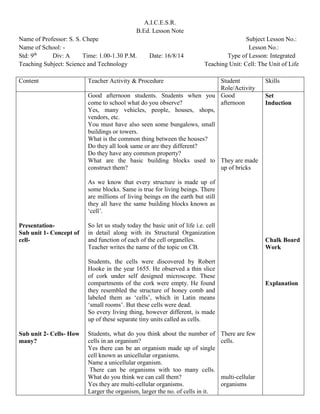
5 Science Lesson Plan-Integrated Skills.docx
- 1. A.I.C.E.S.R. B.Ed. Lesson Note Name of Professor: S. S. Chepe Subject Lesson No.: Name of School: - Lesson No.: Std: 9th Div: A Time: 1.00-1.30 P.M. Date: 16/8/14 Type of Lesson: Integrated Teaching Subject: Science and Technology Teaching Unit: Cell: The Unit of Life Content Teacher Activity & Procedure Student Role/Activity Skills Presentation- Sub unit 1- Concept of cell- Sub unit 2- Cells- How many? Good afternoon students. Students when you come to school what do you observe? Yes, many vehicles, people, houses, shops, vendors, etc. You must have also seen some bungalows, small buildings or towers. What is the common thing between the houses? Do they all look same or are they different? Do they have any common property? What are the basic building blocks used to construct them? As we know that every structure is made up of some blocks. Same is true for living beings. There are millions of living beings on the earth but still they all have the same building blocks known as ‘cell’. So let us study today the basic unit of life i.e. cell in detail along with its Structural Organization and function of each of the cell organelles. Teacher writes the name of the topic on CB. Students, the cells were discovered by Robert Hooke in the year 1655. He observed a thin slice of cork under self designed microscope. These compartments of the cork were empty. He found they resembled the structure of honey comb and labeled them as ‘cells’, which in Latin means ‘small rooms’. But these cells were dead. So every living thing, however different, is made up of these separate tiny units called as cells. Students, what do you think about the number of cells in an organism? Yes there can be an organism made up of single cell known as unicellular organisms. Name a unicellular organism. There can be organisms with too many cells. What do you think we can call them? Yes they are multi-cellular organisms. Larger the organism, larger the no. of cells in it. Good afternoon They are made up of bricks There are few cells. multi-cellular organisms Set Induction Chalk Board Work Explanation
- 2. Subunit 3- Morphology of cells- (Size of the cell) Invention of Microscope Sub unit 4- Modern Cell Theory- Co-operative Activity The Modern Cell Theory has following postulates- 1. All organisms are made up of one or more cells. 2. Cell is the structural and functional unit of life, i.e. all the vital functions of an organism occur within the cells. 3. All cells arise from pre-existing cells, i.e. no cell originates spontaneously but comes into being only by division of cells.“Omnis celula a cellula”. Every Students, what do you think about the size of a cell? Are you sure the cells are always very minute? Teacher shows an egg and says that even an egg is a single cell. An egg and amoeba both are single cells. Size of the cell varies greatly (0.1m to 18 cm) The unit used to measure size of the cell is micrometer. Why do you think that small size of cells is beneficial? Small size ensures greater surface area which in turn ensures greater diffusion of the nutrients into the cell. What else can be the benefit of smaller cell size? Yes, greater exchange of material in and out the cells. It also ensures easy repair of the damaged cells. But how do we observe these cells by naked eyes? What can we use to enable us observe the minute cells? Microscope was first invented by Anton Van Leeuwenhoek in 1673. It was only when the electron microscope was invented in 1940, that the study of cells became possible. Teacher shows some slides of microscope. Teacher shows the gradual modification and advancement in the technique. Teacher asks to describe what it looks like? Teacher makes the students to form groups and discuss among them- What are organs made up of? Cell is said to be structural unit of life. Why? It is also said as the functional unit of life. What could be the reason for it? Students what do you think about formation of new cells? From where can new cells be formed in the body? How? What happens to the existing cells? How can we say that heredity takes place? The points discussed above are nothing but Modern Cell Theory. So students, today we have studied the Concept of cell also the postulates of Modern Cell Theory. They are very minute Students discuss in groups. Questionning Stimulus Variation Questionning
- 3. organism starts its life as a single cell. 4. Cells contain the hereditary information is passed from cell to daughter cell during division. 5. All cells are basically the same in chemical composition. We have seen that the size of the cell is from fraction of millimeter to few centimeters. We have also studied and observed various microscopes. Teacher wipes the CB. 1. What is a cell? 2. Who invents cell? 3. How is simple microscope different than compound, electron and stereo microscope? Teacher gives assignment- Prepare a chart depicting the efforts of various inventors in studying cells and their functions. Closure Assignment Chalk Board Summary Date:14/12/17 Subject: Science and Technology Std.-IX Topic: Cell : The Unit of Life Cell=Small rooms(Latin) Unit to measure cell-1 micrometer = 1/1000 millimeter Cells were first discovered by-Anton Van Leeuwenhoek in 1673. Definition-Smallest structural and functional unit.